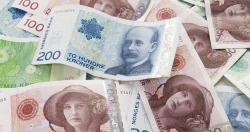Trader’s Guide to Danish Krone

The Central Bank of Denmark has the following roles:
- To maintain stability of prices, to which end Denmark pursues a rate of low inflation of just under 2%.
- To maintain security of payments – the National bank ensures that both electronic and cash payments can be safely settled.
- To ensure financial stability with a system that is robust, and conducive to a functional financial market.
| Broker | Bonus | More |
|---|
A Brief History of the Danish Krone
The very first Danish coins were known as pennies (or pennings) and date back to around AD825–840; however, minting of coins on a larger scale did not take place until the end of the 10th century. Initially, the Danish coinage was based on the Carolingian Silver Standard, but over time the value of the coins was reduced in order to generate income for the state and the monarch, and so it no longer corresponded to its face value. As a result of this, the currency was overhauled numerous times to restore the trust of the public in the currency. The Krone was introduced in 1619, with a new variant of the currency being issued in 1875, which placed the currency on the Gold Standard. The end of the 18th century and most of the 19th century was a time of expansive economic activity for Denmark, and as a result, a better means of payment needed to be developed in order to facilitate this growth. This led to bank notes being used increasingly rather than the traditional coins. The main reason for the introduction of this new Krone was the Scandinavian Monetary Union between Denmark, Sweden and Norway, which had been established in 1873 and which lasted until the outbreak of the First World War when the three currencies all decided to keep the name Krone, but became separate entities. In 1924, Denmark chose to return to the gold standard, and this continued until 1931. In the period 1940 to 1945, the Krone was pegged to the German currency, but after the German occupation ended, the rate of 24 Kroner to the GBP was introduced.
Denmark and its Economy
The Danish economy is mixed and diverse, with a heavy reliance on human resources. The country, however, does also have a number of valuable and significant natural resources, such as gas and oil wells in the North Sea. The nominal GDP of Denmark is the 32nd greatest in the world, and is estimated to be around $333 billion. Although the country has no set national minimum wage, it is also the country with the lowest level of inequality in incomes in the whole world, and there is a low unemployment rate of just 6.2%, well below the average of 11.2% within the Euro area. Cooperative production has a long tradition in Denmark, with several sectors being involved in this style of production including the banking and housing sectors. The main exports of Denmark include manufactured goods, which are responsible for 73.3% of total exports. Instruments and machinery make up a substantial proportion of this total, with chemicals and fuels accounting for much of the rest. Other important exports include agricultural products, meat, fish and energy products. The value of all merchandise and service exports amounts to over half of the country’s GDP, with container shipping being notable within this figure. Denmark has a liberal trade policy within the EU, and the standards of living within the country on a par with other western European countries. Denmark’s largest non-European trading partner is the United States, which accounts for about 5% of the total amount of Denmark’s trade in merchandise, with chemical products, pharmaceuticals, furnishings, Lego, tinned pork and ham, and industrial machinery being the primary exports to the US. Denmark also imports a large amount of American goods, including instruments, machinery, computers and aircraft.


